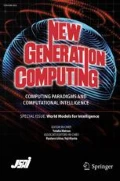Abstract
A novel approach to relational classification based on a Gaussian Random Field and random walks over the graph representing labeled and unlabeled examples is proposed in the paper. Additionally, a class homogeneity measure has been introduced. It can be used for pre-assessment of method applicability for particular networks. The presented experimental results on eight datasets revealed that the framework based on random walk concept possesses the promising potential to effectively classify nodes in the network. Owing to the dependencies discovered, the usefulness of the Random Walk approach to relational classification can be assessed from careful study of proposed class homogeneity distribution in the network.
Similar content being viewed by others
References
Battiston, F., Nicosia, V., Latora, V., “Structural measures for multiplex networks,” Phys. Rev. E, 89, 032804, Mar 2014
Breiman L.: “Bagging predictors,”. Machine Learning 24(2), 123–140 (1996)
Bu D., Zhao Y., Cai L., Xue H., Zhu X., Lu H., Zhang J., Sun S., Ling L., Zhang N., Li G., Chen R.: “Topological structure analysis of the protein-protein interaction network in budding yeast,”. Nucleic Acids Research 31(9), 2443–2450 (2003)
Chapelle O., Schölkopf B., Zien A.: Semi-supervised learning. MIT press, Cambridge (2006)
Desrosiers C., Karypis G.: “Within-network classification using local structure similarity,”. Lecture Notes in Computer Science 5781, 260–275 (2009)
Eldardiry, H. and Neville, J., “Across-model collective ensemble classification” in Proc. of the 25th Conf. on Artificial Intelligence, AAAA, 2011
Eldardiry, H. and Neville, J., “An analysis of how ensembles of collective classifiers improve predictions in graphs,” in Proc. of the 21st ACM International Conference on Information and Knowledge Management, 2012
Fast, A. and Jensen, D., “Why stacked models perform effective collective classification,” in Proc. of the 2008 Eighth IEEE International Conference on Data Mining, IEEE, pp. 785–790 2008
Gallagher, B. and Eliassi-Rad, T., “Leveraging label-independent features for classification in sparsely labeled networks: An empirical study,” in SNA-KDD08, ACM, 2008
Geman S., Geman D.: “Stochastic relaxation, gibbs distributions and the bayesian restoration of images,”. IEEE Transactions on Pattern Analysis and Machine Intelligence 6, 721–741 (1984)
Kajdanowicz, T., Kazienko, P., “Collective classification,” Encyclopedia of Social Network Analysis and Mining, Springer, 2013
Kajdanowicz T., Kazienko P., Janczak M.: “Collective classification techniques: an experimental study,”. New Trends in Databases and Information Systems 185, 99–108 (2012)
Kazienko K., Kajdanowicz T.: “Label-dependent node classification in the Network,”. Neurocomputing 75(1), 199–209 (2012)
Kazienko P., Musial K., Kajdanowicz T.: “Multidimensional social network in the social recommender system,”. IEEE Transactions on Systems, Man and Cybernetics - Part A: Systems and Humans 41(4), 746–759 (2011)
Kimmig A., Mihalkova L., Getoor L.: “Lifted graphical models: a survey,”. Machine Learning 99(1), 1–45 (2015)
Knobbe, A., de Haas, M. and Siebes, A., “Propositionalisation and aggregates,” in Proc. of Fifth European Conference on Principles of Data Mining and Knowledge Discovery, pp. 277–288, 2001
Kravets V. G., Schedin F., Jalil R., Britnell L., Gorbachev R.V., Ansell D., Thackray B., Novoselov K. S., Geim A. K., Kabashin A.V.: “Singular phase nano-optics in plasmonic metamaterials for label-free single-molecule detection,”. Nature materials 12(4), 304–309 (2013)
Krawczyk B.: “One-class classifier ensemble pruning and weighting with firefly Algorithm,”. Neurocomputing 150, 490–500 (2015)
Krawczyk, B., Wozniak, M. and Herrera, F., “On the usefulness of one-class classifier ensembles for decomposition of multi-class problems,” Pattern Recognition, Elsevier, 2015
Lu, Q. and Getoor, L., “Link-based classification,” in Proc. of 20th International Conference on Machine Learning ICML, pp. 496–503, 2003
Musial K., Kazienko P.: “Social networks on the internet,”. World Wide Web Journal 16(1), 31–72 (2013)
Newman M. E. J.: “Finding community structure in networks using the eigenvectors of matrices,”. Physical Review E 74, 036104 (2006)
Nooy, W., Mrvar, A. and Batagelj, V., Exploratory Social Network Analysis with Pajek, chapter 11, Cambridge University Press, 2004
Pearl, J., Probabilistic reasoning in intelligent systems, Morgan Kaufmann, 1988
Perozzi, B., Al-Rfou, R. and Skiena, S., “Deepwalk: Online learning of social representations,” in Proc. of the 20th ACM SIGKDD International Conference on Knowledge Discovery and Data Mining, KDD ’14, pp. 701–710, New York, NY, USA, ACM, 2014
Sen, P., Namata, G., Bilgic, M. and Getoor, L., “Collective classification,” in Encyclopedia of Machine Learning, pp. 189–193, Springer, 2010
Sen P., Namata G., Bilgic M., Getoor L., Gallagher B., Eliassi-Rad T.: “Collective classification in network data,”. Artificial Intelligence Magazine 29(3), 93–106 (2008)
Taskar, B., Abbeel, P. and Koller, D., “Discriminative probabilistic models for relational data,” in Proc. of 18th Conference in Uncertainty in Artificial Intelligence, San Francisco, Morgan Kaufmann Publishers, 2002
Author information
Authors and Affiliations
Corresponding author
About this article
Cite this article
Kajdanowicz, T. Relational Classification Using Random Walks in Graphs. New Gener. Comput. 33, 409–424 (2015). https://doi.org/10.1007/s00354-015-0404-2
Received:
Revised:
Published:
Issue Date:
DOI: https://doi.org/10.1007/s00354-015-0404-2




